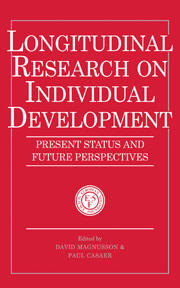Book contents
- Frontmatter
- Contents
- List of principal contributors
- Foreword
- Preface
- 1 Human ontogeny: a longitudinal perspective
- 2 Genes, experience and development
- 3 The human brain and longitudinal research in human development
- 4 Longitudinal research and a biology of human brain development and behaviour
- 5 Cognitive, social and emotional development
- 6 Developmental psychopathology: some historical and current perspectives
- 7 Developmental psychopathology as a research perspective
- 8 Longitudinal research on human aging: the power of combining real-time, microgenetic and simulation approaches
- 9 Development, aging and control: empirical and theoretical issues
- 10 Some methodological issues in longitudinal research: looking ahead
- Index
8 - Longitudinal research on human aging: the power of combining real-time, microgenetic and simulation approaches
Published online by Cambridge University Press: 22 March 2010
- Frontmatter
- Contents
- List of principal contributors
- Foreword
- Preface
- 1 Human ontogeny: a longitudinal perspective
- 2 Genes, experience and development
- 3 The human brain and longitudinal research in human development
- 4 Longitudinal research and a biology of human brain development and behaviour
- 5 Cognitive, social and emotional development
- 6 Developmental psychopathology: some historical and current perspectives
- 7 Developmental psychopathology as a research perspective
- 8 Longitudinal research on human aging: the power of combining real-time, microgenetic and simulation approaches
- 9 Development, aging and control: empirical and theoretical issues
- 10 Some methodological issues in longitudinal research: looking ahead
- Index
Summary
INTRODUCTION
In the present chapter, we proceed from the premise that the study of ontogenesis requires a methodology that is inherently focused on the study of intra-individual change and inter-individual differences in intra-individual change (Bakes, P. B., Reese, & Nesselroade, 1977). We argue, however, that real-time longitudinal studies with single cohorts is not enough. Rather, as outlined already in the 1960s and 1970s in the field of life-span development and aging (Bakes, P. B., 1968; Labouvie, 1980; Nesselroade & Reese, 1973; Schaie, 1965,1979), the final power of longitudinal research rests in its creative use as a rather heterogeneous category of research strategies including microgenetic and simulation approaches (Bakes, P. B. & Goulet, 1971; Bakes, P. B. et al., 1977; Siegler & Crowley, 1991).
The call for a broad range of longitudinal methods is based on the assumption that behavioural development is the result of a complex, multilevel interaction of factors and mechanisms. It is unlikely that this nexus of biologically, socially and societally determined influences on development can be unravelled by longitudinal designs which are essentially descriptive or quasi-experimental in nature. For example, life-span theory suggests that development and aging are jointly determined by age-graded, history-graded, and non-normative systems of influence (Bakes, P. B., 1987; Bakes, Cornelius, & Nesselroade, 1979; Dannefer, 1987; Elder, 1986; Featherman, 1983; Kruse, 1992; Mayer, 1990). Some processes may exhibit a high correlation with age, whereas others are a reflection of historical change. In addition, some events or changes do not occur universally for all people.
- Type
- Chapter
- Information
- Longitudinal Research on Individual DevelopmentPresent Status and Future Perspectives, pp. 153 - 193Publisher: Cambridge University PressPrint publication year: 1993
- 9
- Cited by



